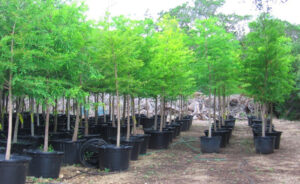Trees have been an integral part of many ancient cultures and civilizations for centuries, with some species being considered sacred or central to certain religious beliefs. From the sacred groves of the Greeks and Romans to modern religious sites where trees are found growing, these historical plants have been imbued with spiritual significance for generations.
In this article, we will explore the various roles that trees have played in ancient cultures and how they remain revered today. We will also look at some of the various religious beliefs associated with different tree species, as well as their spiritual symbolism.
But first, if you are in need of tree removal service in Charleston, SC, Connor Tree Service is here to help! Okay, let’s begin.
Trees in Ancient Religious Beliefs
In ancient cultures, certain tree species had a special relationship with gods or deities. Olive trees held particular importance among the Greeks while cedar was revered by Egyptians.
In some cases, there were actual shrines erected around particular species which were meant to honor them or show devotion to various gods. Other religions included offerings or sacrifices at sacred sites which could include a variety of trees configured in specific arrangements.
These steps all served to recognize how important these plants were within religion despite their relatively small size compared to humans and other creatures.
Trees in Ancient Mythology
Trees featured prominently in mythology as well, often embodying metaphysical concepts like eternity and knowledge – Yggdrasil from Norse mythology is one such example who represented the world tree while Hindu Banyan Tree is also a notable figure as it purportedly provided protection from evil spirits.
Furthermore, numerous heroes throughout various stories interacted directly with trees whether it be Hercules using olive wood to complete his labors or Orpheus who sang hymns of sorrow towards willows after his beloved Eurydice perished.
This intricate role between humans, nature, and the divine still carries on into contemporary storytelling which continues to illustrate how significant these ancient beings once were – and still are today!
Get an assessment and quote from Connor Tree Service today.
The Practical Uses of Trees Throughout History
The profound connection between humanity and trees throughout history doesn’t only encompass spiritual ties but extends beyond this into more practical aspects of everyday life.
Trees provide us with essential resources such as food, shelter, and fuel which have been key for survival since our early beginnings and continue to be so even still now! Let’s explore some examples below:
Trees as a Source of Food & Medicine
Throughout much of human history, trees have played an important role in providing sustenance both through their fruits and seeds as well as their medicinal qualities. While we doubt tree removal service in Charleston was prevalent back then, there were those who knew how to tap into their natural health benefits.
Olives were among those that figured prominently in diets across Mediterranean cultures during antiquity while ginkgo was used medicinally during China’s Shang Dynasty around 800 BC–1046 BC period amongst several others too!
Whether it be edible goods now used commonly today like dates and mangoes that originate from distant pasts or simply items no longer consumed that informed our ancestor’s understanding of nutrition and health such as acorns and chestnuts – tree resources remain paramount for sustaining life on this planet.
Trees as Shelter and Building Materials
Trees likewise provided materials needed for constructing shelters which are especially evident when looking at pre-industrial societies prior to the mass production capabilities we enjoy today.
Cedar was popular among Egyptians for roofing, while redwood found favor with Native Americans thanks to its weather-resistant qualities, and juniper was used extensively by Persians in the wake of earthquakes.
Oak became a staple of northern Europe before industrialization, pine was the lumber of choice across Asia in antiquity, the palm was integral to South American temple building pre-Columbian period, Celts sought out yew for nails on boats around 500 BC, and walnut has been used for musical instruments since 1000 BC.
These varied applications have been passed down through generations demonstrating the brilliance of traditional knowledge. Ancient trees are important as they manifest an essential connection between humankind and nature that reaches back in time.
Conclusion
From global spiritual connections spanning thousands of years stretching back into antiquity right through until present-day conversations about environmentalism — we can clearly see just how incredibly important ancient trees continue to be.
Not only do they serve vital practical uses providing us with food nourishment and material supplies but also inspire moments within our lives forging connections between ourselves and nature itself — something indispensable when navigating our ever more complicated and fast-paced lives nowadays.
Acknowledging the immense influence these magnificent organisms have had upon us both historically and currently going forward shows that upholding their sacredness shall remain keystone values when sustainable futures.
Tree service in Charleston has had a long history and the ancient trees of today are still playing a part in it. There are some trees that can pose a threat to the safety of your property and should be removed by a professional tree removal service.
When removing trees, it is important to make sure that you are dealing with an experienced tree removal service in Charleston that will not only remove the trees quickly and safely but also handle all of the required paperwork, permits, and insurance needs.
Reach out to Connor Tree Service today to get professional tree removal services in Charleston, SC!








